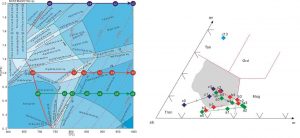
The Earth’s continental crust was mainly formed in the Archean period, ~2.5 to 4.0 billion years ago, and is chiefly composed of tonalite, trondhjemite and granodiorite (TTG rocks). These three kinds of rock preserve pivotal information of the formation and evolution of early continental crust. Study on the petrogenesis of TTG rocks can elucidate the tectonic regimes of the early Earth. A recent study using a quantitative phase modeling approach to document the partial melting process of tonalitic gneiss presents an innovative viewpoint of petrogenesis of Archean trondhjemite in the Eastern Hebei, China.
An advanced method for studying the petrogenesis of granitoids involves conducting high-temperature and high-pressure experiments by selecting different bulk-rock compositions as starting materials and comparing the melt compositions with those of real rocks. Results from previous experimental studies suggest that the Archean TTG rocks were formed by partial melting of hydrous mafic rocks, and low melting degrees or melting under high-pressure conditions tends to produce trondhjemitic melt. Field observations in many Precambrian terrains shows that trondhjemite commonly occurs as small veins, intrusions and/or as leucosomes within tonalitic gneiss. This suggests that that trondhjemitic melt can be generated by partial melting of tonalitic rocks. Thus, a systematic study was undertaken to simulate the origin of trondhjemite.
Taking trondhjemitic rocks from the Eastern Hebei as an example, the authors present phase modeling for a representative tonalitic sample using a recent internally consistent thermodynamic data set, available activity models of minerals and melt and the THERMOCALC software. On the basis of the calculated P-T pseudosection, melt compositions were constrained under different P-T conditions, and compared with those of trondhjemitic rocks in the Eastern Hebei. The simulation results show that melts generated under 0.9~1.1GPa/800~850?C with melting degree of 5~10wt.% are comparable with trondhjemitic rocks from the Eastern Hebei in both major and trace element compositions. In addition, zircon U-Pb isotopic dating reveals that the formation age of trondhjemitic veins in the Eastern Hebei is consistent with the metamorphic age of the country tonalitic gneiss, further supporting the viewpoint that trondhjemitic rocks can be formed by the partial melting of tonalitic rocks.
Using a quantitative phase modeling approach, the researchers simulated partial melting of tonalite and have proposed a new view that trondhjemite can be a melting product of tonalite, and not simply produced by the partial melting of mafic rocks under high-pressure conditions. This will be significant for elucidating the Archean tectonic regime for the formation of TTG rocks. Moreover, this study provides a new and effective method for documenting of the genesis of granitoids.
Reference:
ShiWei Zhang et al, Petrogenetic simulation of the Archean trondhjemite from Eastern Hebei, China, Science China Earth Sciences (2017). DOI: 10.1007/s11430-016-9025-9
Note: The above post is reprinted from materials provided by Science China Press.










